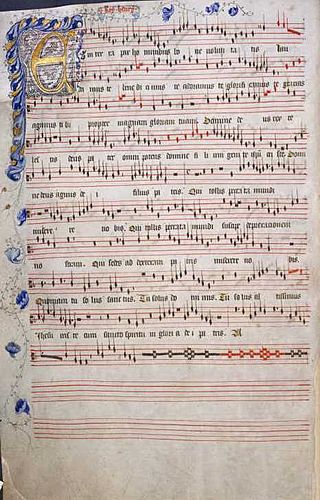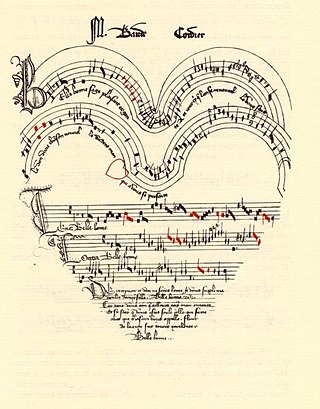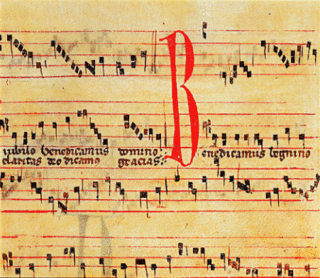Related Research Articles

Renaissance music is traditionally understood to cover European music of the 15th and 16th centuries, later than the Renaissance era as it is understood in other disciplines. Rather than starting from the early 14th-century ars nova, the Trecento music was treated by musicology as a coda to Medieval music and the new era dated from the rise of triadic harmony and the spread of the contenance angloise style from Britain to the Burgundian School. A convenient watershed for its end is the adoption of basso continuo at the beginning of the Baroque period.

Guillaume Du Fay was a composer and music theorist of early Renaissance music, who is variously described as French or Franco-Flemish. Considered the leading European composer of his time, his music was widely performed and reproduced. Du Fay was well-associated with composers of the Burgundian School, particularly his colleague Gilles Binchois, but was never a regular member of the Burgundian chapel himself.

Ars antiqua, also called ars veterum or ars vetus, is a term used by modern scholars to refer to the Medieval music of Europe during the High Middle Ages, between approximately 1170 and 1310. This covers the period of the Notre-Dame school of polyphony, and the subsequent years which saw the early development of the motet, a highly varied choral musical composition. Usually the term ars antiqua is restricted to sacred (church) or polyphonic music, excluding the secular (non-religious) monophonic songs of the troubadours, and trouvères. Although colloquially the term ars antiqua is used more loosely to mean all European music of the 13th century, and from slightly before.

The Burgundian School was a group of composers active in the 15th century in what is now northern and eastern France, Belgium, and the Netherlands, centered on the court of the Dukes of Burgundy. The school inaugurated the music of Burgundy.

Antoine Busnois was a French composer, singer and poet of early Renaissance music. Busnois and colleague Johannes Ockeghem were the leading European composers of the second half the 15th century, and central figures of the early Franco-Flemish School.

Pierre de la Rue was a Franco-Flemish composer and singer of the Renaissance. His name also appears as Piersson or variants of Pierchon and his toponymic, when present, as various forms of de Platea, de Robore, or de Vico. A member of the same generation as Josquin des Prez, and a long associate of the Habsburg-Burgundian musical chapel, he ranks with Agricola, Brumel, Compère, Isaac, Obrecht, and Weerbeke as one of the most famous and influential composers in the Netherlands polyphonic style in the decades around 1500.
Arnold de Lantins was a Netherlandish composer of the late medieval and early Renaissance eras. He is one of a few composers who shows aspects of both medieval and Renaissance style, and was a contemporary of Dufay during Dufay's sojourn in Italy.

The Old Hall Manuscript is the largest, most complete, and most significant source of English sacred music of the late 14th and early 15th centuries, and as such represents the best source for late Medieval English music. The manuscript somehow survived the Reformation, and formerly belonged to St. Edmund's College, a Roman Catholic school located at Old Hall Green in Hertfordshire. It was sold to the British Library after an auction at Sotheby's in 1973.
Johannes Cesaris was a French composer of the late Medieval era and early Renaissance. He was one of the composers of the transitional style between the two epochs, and was active at the Burgundian court in the early 15th century.
Fauxbourdon – French for false drone – is a technique of musical harmonisation used in the late Middle Ages and early Renaissance, particularly by composers of the Burgundian School. Guillaume Dufay was a prominent practitioner of the form, and may have been its inventor. The homophony and mostly parallel harmony allows the text of the mostly liturgical lyrics to be understood clearly.

Baude Cordier was a French composer in the ars subtilior style of late medieval music. Virtually nothing is known of Cordier's life, aside from an inscription on one of his works which indicates he was born in Rheims and had a Master of Arts. Some scholars identify him with Baude Fresnel, a harpist and organist in the court of Philip the Bold, though other scholars have rejected this.

The Codex Las Huelgas is a music manuscript or codex from c. 1300 which originated in and has remained in the Cistercian convent of Santa María la Real de Las Huelgas in Burgos, in northern Spain. The convent was a wealthy one which had connections with the royal family of Castile.
Intabulation, from the Italian word intavolatura, refers to an arrangement of a vocal or ensemble piece for keyboard, lute, or other plucked string instrument, written in tablature.

The Chantilly Codex is a manuscript of medieval music containing pieces from the style known as the Ars subtilior. It is held in the museum at the Château de Chantilly in Chantilly, Oise.
Johannes de Quadris (Quatris) was an Italian composer of the early Renaissance. He was one of the first composers of polyphony associated with the basilica of St. Mark's in Venice, and the earliest known composer to write a polyphonic setting of the Magnificat for four voices.
Francesco Cellavenia was an Italian composer of the Renaissance, active in Casale Monferrato.
George de La Hèle was a Franco-Flemish composer of the Renaissance, mainly active in the Habsburg chapels of Spain and the Low Countries. Among his surviving music is a book of eight masses, some for as many as eight voices. While he was a prolific composer during his time in Spain, much of his music was destroyed in 1734 in the burning of the chapel library in Madrid.
Richard Loqueville was a French composer active during the transition between Medieval and Renaissance music. A musician at Cambrai Cathedral, Loqueville was a harpist and teacher, whose students included Edward III, Duke of Bar and the influential composer Guillaume Du Fay.
Rodrigo de Ceballos was a Spanish composer.
Jehan Vaillant was a French composer and music theorist. He is named immediately after Guillaume de Machaut by the Règles de la seconde rhétorique, which describes him as a "master … who had a school of music in Paris". Besides five pieces of music surviving to his name, he was also the author of a treatise on tuning. With Grimace and F. Andrieu and P. des Molins, Vaillant was part of the post-Machaut generation whose music shows few distinctly ars subtilior features, leading scholars to recognize Vaillant's work as closer to the ars nova style of Machaut.
References
- Masakata Kanazawa: "Janue, Antonius", Grove Music Online ed. L. Macy (Accessed May 4, 2007), (subscription access) Archived 2008-05-16 at the Wayback Machine
- Charles Hamm/Jerry Call: "Sources, MS, §IX", Grove Music Online ed. L. Macy (Accessed May 4, 2007), (subscription access) Archived 2008-05-16 at the Wayback Machine
- Corpus mensurabilis musicae (CMM), vol. 70 (edited by Masakata Kanazawa), contains all the works attributed to him.
- R. Giazzoto: La musica a Genova nella vita pubblica e privata dal XIII al XVIII secolo. Genoa, 1951.